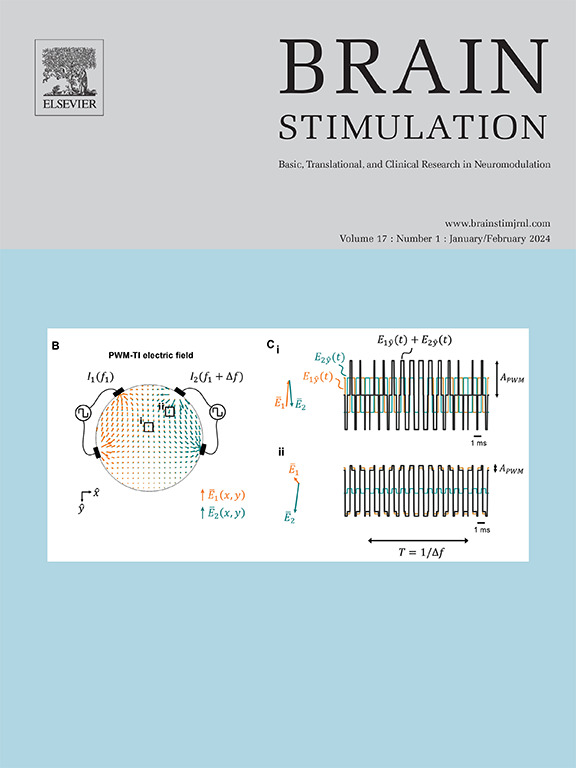Transcranial ultrasound stimulation modulates neuronal membrane potentials across broad timescales in the awake mammalian brain
IF 8.4
1区 医学
Q1 CLINICAL NEUROLOGY
引用次数: 0
Abstract
Background
Transcranial ultrasound stimulation (TUS) offers noninvasive neuromodulation with high spatiotemporal precision, but its cellular-level effects in the awake brain remain poorly understood.
Objective
We investigated how low-intensity TUS modulates membrane voltage dynamics in individual cortical neurons in awake mice.
Methods
Using the genetically encoded voltage indicator SomArchon, we performed high-speed kilohertz voltage imaging in awake head-fixed mice. TUS was delivered with a 0.35 MHz transducer at 10 or 40 Hz pulse repetition frequency, at intensities below the estimated threshold for auditory brainstem activation. We analyzed changes in membrane potentials (Vm), spiking, and coordination across simultaneously recorded neurons.
Results
TUS evoked rapid (<10 ms) Vm depolarizations in 42.8 % of neurons, while only increasing spiking in 20.5 % of neurons, highlighting a direct effect of TUS on modulating synaptic inputs. Many neurons were entrained at both PRFs (20.8 % at 10 Hz; 12.7 % at 40 Hz) with Vm exhibiting significant phase-locking to individual TUS pulses. Vm entrainment was accompanied by increased temporal coordination across neurons and reset network synchrony. Furthermore, TUS-evoked cellular responses adapted over time, often transitioning from membrane depolarization to hyperpolarization upon repeated exposures, demonstrating prominent response depression.
Conclusion
By resolving single-neuron responses in the awake mammalian brain, our results demonstrate that TUS directly activates individual cortical neurons with latencies often shorter than 10 ms. TUS pulsed at physiologically relevant frequencies of 10 and 40 Hz robustly entrains neural dynamics, alters network coordination and evokes neuronal plasticity. These results highlight the therapeutic potential of designing TUS pulsing patterns to target desired neural dynamics and plasticity features.
经颅超声刺激在清醒的哺乳动物大脑中调节神经元膜电位。
背景:经颅超声刺激(TUS)提供了具有高时空精度的非侵入性神经调节,但其在清醒大脑中的细胞水平作用仍然知之甚少。目的:研究低强度电流对清醒小鼠皮质神经元膜电压动态的调节作用。方法:利用基因编码电压指示器SomArchon,对清醒头固定小鼠进行高速千赫兹电压成像。TUS用一个0.35 MHz的换能器以10或40 Hz的脉冲重复频率传递,强度低于听觉脑干激活的估计阈值。我们分析了同时记录的神经元的膜电位(Vm)、峰和协调的变化。结论:通过分析哺乳动物清醒大脑中的单个神经元反应,我们的研究结果表明,TUS直接激活单个皮质神经元,其潜伏期通常短于10 ms。在生理相关频率10和40赫兹脉冲的TUS强有力地携带神经动力学,改变网络协调和唤起神经元的可塑性。这些结果强调了设计TUS脉冲模式以针对所需的神经动力学和可塑性特征的治疗潜力。
本文章由计算机程序翻译,如有差异,请以英文原文为准。
求助全文
约1分钟内获得全文
求助全文
来源期刊

Brain Stimulation
医学-临床神经学
CiteScore
13.10
自引率
9.10%
发文量
256
审稿时长
72 days
期刊介绍:
Brain Stimulation publishes on the entire field of brain stimulation, including noninvasive and invasive techniques and technologies that alter brain function through the use of electrical, magnetic, radiowave, or focally targeted pharmacologic stimulation.
Brain Stimulation aims to be the premier journal for publication of original research in the field of neuromodulation. The journal includes: a) Original articles; b) Short Communications; c) Invited and original reviews; d) Technology and methodological perspectives (reviews of new devices, description of new methods, etc.); and e) Letters to the Editor. Special issues of the journal will be considered based on scientific merit.
 求助内容:
求助内容: 应助结果提醒方式:
应助结果提醒方式:


